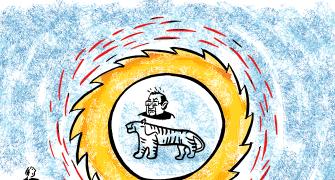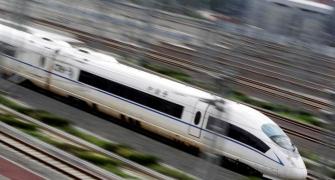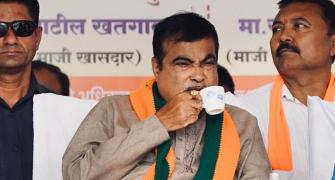The combined share of customs and excise duties, service tax, and value-added tax in India’s gross domestic product reached an all-time high of 10.5 per cent.
Illustration: Dominic Xavier/Rediff.com

There has been a steady rise in indirect taxes (net of subsidies) in recent years, pushing up retail prices of commonly used goods and services.
The combined share of customs and excise duties, service tax, and value-added tax (VAT) in India’s gross domestic product (GDP) reached an all-time high of 10.5 per cent during the financial year 2016-17, up from 7.7 per cent three year ago.
The previous high was 10.1 per cent during the Rajiv Gandhi government in 1987-88.
Experts say this could be one of the reasons for a demand slowdown in the economy, as higher indirect taxes raise retail prices, hurting demand as well as production.
“Indirect taxes, such Customs, excise, VAT, and service tax, are part of the retail price for goods and services. As such, any increase in taxes raises consumer prices, adversely impacting their demand,” says G Chokkalingam, founder and managing director, Equinomics Research & Advisory.
The past three years have witnessed a steady rise in Customs or excise duty on commonly used goods, such as petroleum products, metals and sugar, automobiles and consumer durables, among others.
Besides, service tax has been hiked steadily to 18 per cent (under the goods and services tax, or GST, regime) from 12.4 per cent in 2014.
The period also saw a sharp cut in government subsidies on fuel, farm inputs, and agri-procurement.
This has resulted in healthy indirect tax collections, despite sub-par growth in industrial production and GDP during the period.
According to the data from the Central Statistics Office, net indirect tax collection (Centre and states combined) grew at a compounded annual growth rate (CAGR) of 22.3 per cent in the past three years, against 10.6 per cent annualised growth in GDP at current prices during the period.
In value terms, indirect tax collections (net of subsidies) jumped to Rs 15.9 lakh crore in FY17, from Rs 8.7 lakh core three years ago.
In the same period, GDP, at market prices, was up 35 per cent from Rs 112.2 lakh crore in FY14 to Rs 15.2 lakh crore during FY17.
In other words, indirect taxes now form a greater part of retail prices than in the past, blunting the downward effect of lower international commodity prices.
The trend is likely to sustain in FY18, as various indirect taxes have been replaced by the GST.
GST rates on most goods and services are either revenue-neutral or higher, so as to enable the central government to raise additional revenues for compensating states for any shortfall.
Economists say higher indirect taxes have a bigger impact on the wallets of the poor and low-income families, compared to high-income earners, as the former end up paying a larger share of their income as taxes.
“The marginal propensity to consume is near to one for people at the bottom of the pyramid.
They spend nearly all their income on things like food, clothing, mobile bill, and other small-ticket consumer items.
Given this, a greater proportion of their income goes as indirect taxes, compared to high-income people, who save a significant portion of their recurring income.
This makes indirect taxes regressive and hurts demand and production in the economy,” says Devendra Pant, chief economist and head of public finance, India Ratings.
In contrast, direct taxes such as personal income taxes are progressive in nature, as it kicks in only after a certain income threshold, and the rich pay a higher portion of their income as taxes, compared to low-income earners.
The impact is visible in the finances of the listed fast-moving consumer goods companies such as Hindustan Unilever, ITC, Dabur, Nestlé, Colgate-Palmolive, Tata Global Beverages, and Godrej Consumer, among others.
Their combined revenues grew at a CAGR of just 4.4 per cent in the past three years, sharply down from 13.6 per cent annualised growth during the last two years of the United Progressive Alliance (UPA)-II government.
In comparison, consumer durables and automobile makers show a mild pick-up in revenue growth.
The combined revenues of listed consumer durables and automakers grew at a CAGR of 9.6 per cent in the past three years against 8.4 per cent during the last two years of the UPA-II government.
Experts attribute the dichotomy to the fact that consumer durables and automobiles are largely bought by high-income earners and largely on credit, which cushions the impact of higher prices.
“Retail credit is booming and that could explain the faster growth in big-ticket consumer goods despite a not-so-favourable macros in recent years,” says Dhananjay Sinha, head of research at Emkay Global Financial Services.










